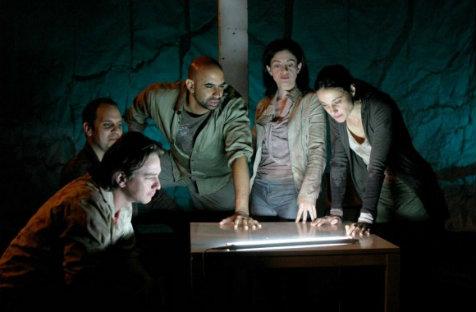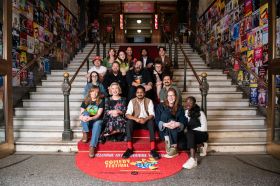Mari Lourey’s Bare Witness attempts to encapsulate the chaos of war. The play follows a team of photojournalists working in war zones as they chase the danger from Kosovo to Timor and then to Iraq. Dani Hill is introduced to us in the first scene as the rookie photographer, fresh out of an internship and just wanting to take good pictures. After what appears to be a drunken encounter on a big night out she meets and follows Jack Stewart, already a luminary at his trade, as he prepares to travel to Kosovo. There she confronts the realities of war and tries to capture the impact it has on people’s lives.
Each scene in Bare Witness represents a photograph on a spectrum that counts down from 011 to 001. Structured throughout the piece are photographic instructions, highlighting the technicality of the process followed to achieve an emotional result in a still image. And an emotional rollercoaster it is. Bare Witness asks some powerful questions and delivers some powerful scenes. Weaving drama with dance, the play takes on a multifaceted form no doubt intended to be representative of the fragmentary lives led by war journalists.
Bare Witness captures the intensity of the subject matter with an interactive set utilising harsh fluorescent lighting against a video projected onto a wrinkled white sheet. A lone cellist strums a live music score ominously throughout, synchronising her music to the haunting soundtrack and at times becoming part of the action herself. The ‘special effects’ highlight is a cracker that lights up the stage in several explosions. The play is busy, with numerous characters, lighting effects and a riveting musical score.
However, in interweaving so many different elements into the drama, the focus of the plot often gets lost. In one of the more poignant sub-plots, Dani travels to East Timor where she meets José, whose name she constantly mispronounces. Treating him at first like a local lackey, she eventually learns to respect him and treat him as an equal, until they are eventually attacked together after taking photos of bodies that have had their ears cut off. If explored further, such powerful storylines could be more effective at drawing people in to the jumbled action. Similarly, the character of Violetta Hakim, a mother who has left her son behind in Beirut, opines about buying herself 10 pairs of shoes each year. Again, we are given only a glimpse of the anguish she feels at being torn between her career and the real world, before being again whisked away on another chaotic interlude.
It is through these glimpses of lives away from war that Lourey attempts to humanise her characters. Dani’s grief-stricken call to her gravely ill mum at home, who she hadn’t seen for five years, demonstrates the sacrifices made by the individuals involved.
Bare Witness also raises some ethical questions. Early on in the piece we are confronted with a situation where Dani is aghast at Jack’s ‘manipulation’ of a photograph. As it eventuates, the death of a fellow journalist provides an opportunity for each of the characters to take turns at practicing their craft in order to tell the story. The frenetic energy of the characters is highlighted in this scene, as the juxtaposition of different poses each tell their own story to the viewer.
Bare Witness is confronting theatre. The grittiness of the lighting, interactive musical score and heightened physicality of the piece, all under Nadja Kostich’s direction, give the impression of a play that wants to make a lasting impact, but there is something about the piece that lacks connectivity and flow. Without this cohesion, the various scenes, characters and stylised movements appear as illusionary as the disparate world they are trying to represent, and the piece falls short of delivering that breathless impact the photojournalists are so desperately trying to capture. Regardless of such failings, Bare Witness remains a momentous piece of work that bravely attempts to create a stylised depiction of the chaos experienced in war zones.
Rating: 3 stars out of 5
Bare Witness
A La Mama/fortyfivedownstairs production
Writer: Mari Lourey
Director: Nadja Kostich
Designer: Marg Horwell
Musician/Composer: Kristin Rule
Lighting Design: Emma Valente
Video Design: Michael Carmody
Cast: Daniela Farinacci, Adam McConvell, Eugenia Fragos, Todd Mac Donald and Ray Chong Nee
Duration: 75 mins
Theatre One, The Street Theatre, Canberra
6 – 10 November
Additional dates:
West Gippsland Arts Centre, Warragul: 13 November
Her Majesty’s Theatre, Ballarat: 15 November
Mildura Arts Centre: 17 November
Theatre Royal, Hobart: 21 – 22 November





